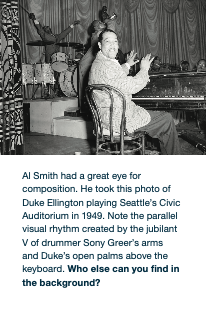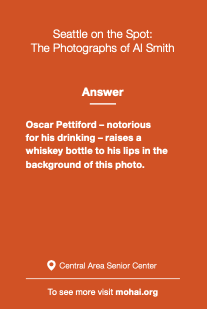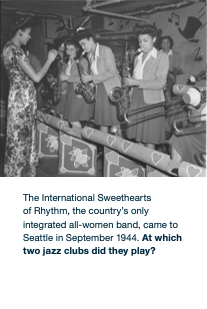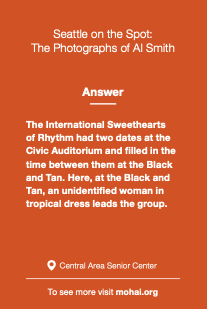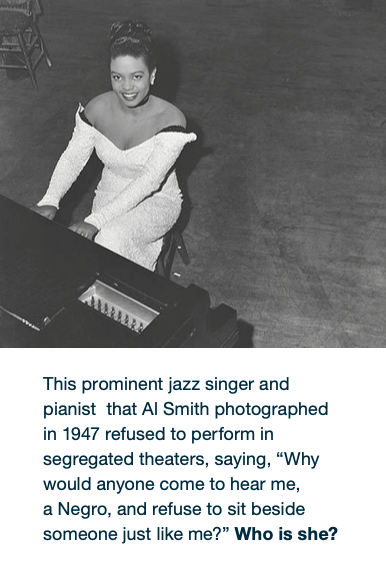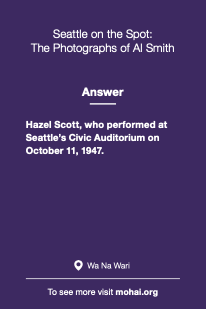Museum of History and Industry (MOHAI)
Preserving a legacy, celebrating history: a community designed solution for MOHAI
The Museum of History and Industry (MOHAI) wanted to do some blue-sky thinking around expanding beyond their physical space and place historic artifacts back into their cultural context. Specifically, they wanted to place their collection of photos by Al Smith in institutions around the Central District (CD) of Seattle. What kind of digital solution could help residents and newcomers to the CD find and interact with these photos?
The goal is to help preserve the stories and the memories of a neighborhood through Smith’s photos and to teach newcomers about the history of a community.
The Solution:
To understand if this project would be valuable to the community, we interviewed people in the CD. Everyone we talked to knew of Al Smith’s photos, and they all had personal stories to share. History is not contained in images alone; people wanted the solution to preserve their memories and personal histories.
With the input from our research participants, and community leaders, we created a framework -a game- for the community to adopt as a solution. To test our solution, we created analog cards and used a templated scavenger hunt app to set up a game.
Deliverables: Concept, Research Summary, App Comparison
Time frame: 12 weeks
UX Advisor: Courtney Artuso, Sr. User Experience Designer and Voice Designer - Alexa, Amazon
Community Advisors: Danuta Kasprzyk, PhD - Research Professor UW; BJ Cummings, MA, Community Engagement Manager, UW
Collaborator: Maryska Valentine, UX Designer
IMPLEMENTATION: How to create the game with the community
MOHAI’s role would be that of facilitator and administrator: organizing the exhibits, and updating and maintaining the app. The community gets to choose what photos will be exhibited in their institution, be part of the exhibit planning, and write the trivia.
SECONDARY GOALS:
Setting up the framework would take some time. But, it would tie in nicely with MOHAI’s secondary goals: to create community engagement, nurture long-term relationships with community leaders, and engage a whole new audience.
The Photographs and the Photographer
Photo by Al Smith, courtesy of MOHAI
Al Smith, self portrait, courtesy of MOHAI
Time Sensitive
Al Smith’s photos document 65 years of the vibrant African American history in Seattle’s Central District.
As the population ages, and the community is slowly displaced by gentrification, there are fewer and fewer people who can give some context to these photos.
“There’s some bitterness in the community. I think the work could build a sense of community, because boy, we sure need that now.”
The Target Audience
People who live, work or have historic ties to the Central District.
“Whatever gets designed needs to have physical action…you create community through games and fun interactive pieces. It becomes imprinted in you when you’ve playfully interacted with someone.”
The Strategy
After our research showed that the community found the project of great value, we needed to find out how the community would like to interact with the photos. We spent the next ten weeks continuing with research, as our solution needed to be community informed. We ran iterations of ideas and prototyping concurrently with our research.
Research Methodologies
Field Research
We did several trips to the Central District (CD), to understand the physical landscape. How walkable is the CD? Is a walking tour a good solution? How accessible are the institutions and the streets?
Expert Interviews
We conducted interviews with a community leader and a research scientist (not associated with the CD) as a method of determining best practices for interviewing community members outside of our own communities.
Quantitative Research
We did online research into Central District's demographics, cellphone usage, adoption of apps vs. mobile web, and gaming as an effective learning tool.
Participatory Research (Qualitative)
We conducted community interviews at the community Starbucks in the CD. We also conducted more formal phone and in-person interviews to learn about beliefs and preferences.
Competitive Analysis
Technology Research: What kind of digital solutions are already out there, are other museums trying to do similar things? We looked into museum apps, walking apps and scavenger hunt apps.
Concept Testing with Community leaders
As our resources were limited, we leveraged existing relationships and focused efforts on conducting participatory research with community leaders in the CD.
Usability Testing
We tested both the app and the analog cards with community members. We wanted to know if a game could be an effective way to exchange stories and learn about the CD and Al Smith’s photographs.
key Findings
Qualitative Research
Key Findings:
Even though most current residents of the CD use smart phones, the elderly, who have historic ties, are not digitally engaged.
If it’s a mobile experience it should be an app not mobile web.
Quantitative Research
Key Findings:
The community wants a multi-sensory, interactive way to experience the photographs in community gathering places.
They want a reason to engage.
The community needs to be involved in the design process.
Ideation:
ABANDONED IDEAS:
Walking Tour
We initially investigated a walking tour as a solution. But our field research showed that institutions are too far apart and 6 out of 7 of our interviewees were not willing to walk that far.
AR and Large Interactive Screens
We abandoned the Augmented Reality app (think Pokemon GO) and large interactive screens, because of budgetary constraints.
Installations
My 3D installation ideas were really fun to do, but those were not actually solving for the problem of findability. Our job was to show MOHAI what is possible in the digital realm.
Key Findings from Community Interviews
Create a framework to design with the community.
Make it fun, make it interactive!!
The solution needs to be both analog and digital.
Based on our research a trivia/scavenger hunt game could be an effective solution.
Creating the Game
We created analog cards and created trivia around Al Smith’s photos and the history of the CD.
Key Findings for Technology
MOHAI’s Technical Constraints
No technical staff
No resources for adding on to MOHAI’s website
No Budget
The Digital Solution
Because there was no budget we recommended using a templated game app.
I looked into what templated game apps are available, evaluated and tested many different ones, and finally selected one called Goose Chase, based on functionality, ease of use and branding options.
Evaluations of existing gaming apps
THE GAME
We created site specific games based on Al Smith’s photos.
Part scavenger hunt/part trivia, we created site-specific games and let community members engage with Al Smith’s photos in a playful way.
Concept Testing
We tested the game, both digital and analog versions with the target audience to determine whether it’s an effective method of learning about Al Smith’s work.
In-person testing with target audience
Participants had a lot of fun playing the game, learned about Al Smith and the institutions, and exchanged stories related to the photos.
In-person testing with target audience.
“[The game] jogs your memory and you want to know more – that’s fun.”
“This is very cool, you’re very on it.”
Testing with Community Leaders
We asked community leaders if they thought the game would work within their institution.
“This [game] would be helpful to show people that there were all these things that happened at Washington Hall – they could rent the Hall and play the game [on the app].
It’s an effective way to teach newcomers about the history of the CD.”
Feedback from MOHAI
“The community is such an important part of this project – thank you for putting so much thought into conducting research and testing within the community.
Wow, what a creative solution – a game – I never would have thought of that!”
































